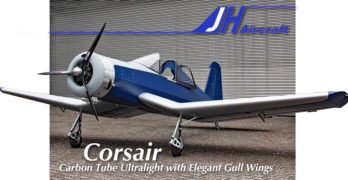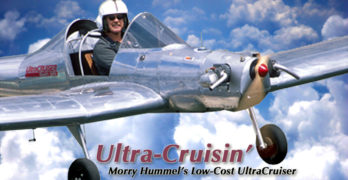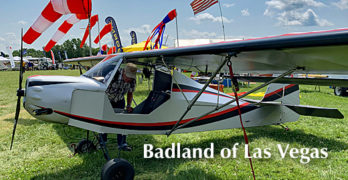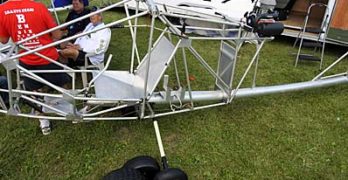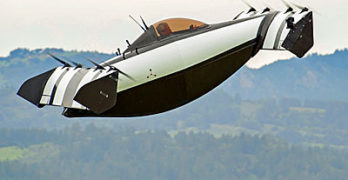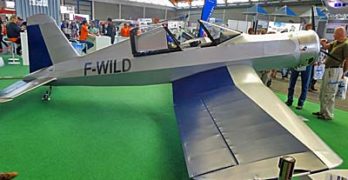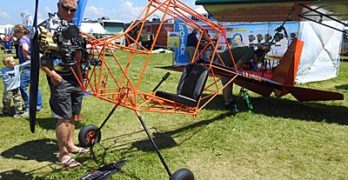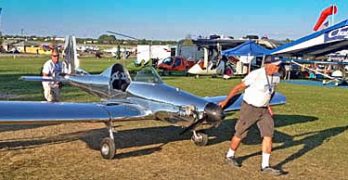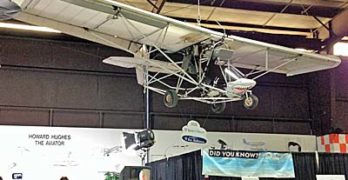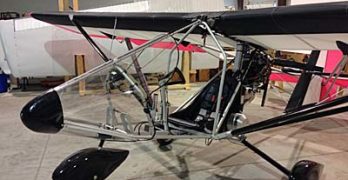Most ultralight aircraft (officially: “ultralight vehicles”) are rather simple constructions. They must be to stay within the tight constraints of a 254-pound maximum empty weight.*
That’s not a negative comment about them. Actually, it’s the opposite.
To build a flying airplane that weighs less than the engine alone on a Light-Sport Aircraft, a designer has to be unusually clever.
All aircraft are constrained in weight by the laws of physics. Ultralights are further constrained by regulation.
A key way to keep an aircraft light is to keep it simple. Indeed most 103 ultralights are quite basic. However, as years passed some engineers have found intriguing solutions. I recently wrote about the composite Swan. Why not one using extensive carbon fiber?
Carbon Corsair
German developer Jörg Hollmann took a different approach, one that consumed a few years of effort.
He wanted an aircraft that resembled the famous World War II F4U Corsair fighter.
Search Results for : Part 103
Not finding exactly what you expected? Try our advanced search option.
Select a manufacturer to go straight to all our content about that manufacturer.
Select an aircraft model to go straight to all our content about that model.
One More Part 103 Ultralight Aircraft: UltraCruiser by Hummel Aviation
In April, lots of readers were clearly pleased with the “Vintage Ultralights” series. Thanks to our cooperation with Videoman Dave and his popular YouTube channel, we were able to present ten well-proven aircraft that could be purchased for well under $10,000 …assuming you could find one that met your needs and passed a careful inspection.
Bargains may not be the easiest aircraft to find and buy yet the effort can pay off with a flying machine allowed by your budget and which can bring a smile to your face. That seems worth the search.
However, our 10-aircraft review was not exhaustive. Even more choices are available! Some very modestly priced aircraft — Legal Eagle is one of several (yes, several!) possibilities — are available as a new aircraft purchases for a fairly small amount of money. Another is Hummel Aviation’s UltraCruiser (see lots of links below).
Badland Aircraft — Kitfox Lite, A True Part 103 Ultralight Aircraft, Returns to the Market
Once we had Avid Flyer. It begat Kitfox, which begat many models before returning to the starting point by creating a Part 103 ultralight vehicle* called Kitfox Lite …what else? At that time Kitfox was owned by its principal, Dan Denney.
A good marketer Denney’s Kitfox once employed a whole staff of sales people following up on loads of leads that the then-new design was generating. Even now, decades later, Kitfox, doing business as Fox Air, is building one of the most successful kit-plane designs in aviation history. (For the facts and market position of Kitfox visit our Tableau Public page of LSA and SP kit statistics.)
While the Dan Denney version of Kitfox Inc., addressed strong demand, they also began working to widen the market they served. Kitfox had found success as a two seater in various configurations but did a market exist for a single seater?
Hawk (Part 103) Ultralights Making a New Comeback; Interest Appears Strong
CGS Hawk is one of our most storied brands of ultralight and light aircraft. Built in one and two seat varieties in several variations for 35 years, more than 2,000 are flying. Hawk has proven a significant contributor to the light aircraft fleet. Lots of owners I’ve spoken to simply love their Hawk.
After many years of production by the company named after its founder Chuck Slusarczyk — the “C” in CGS — the well known brand is now on its third …and fourth, owners. It’s all good, though. Let me explain.
Current brand owner is Terry Short (article). He will remain key to the manufacture of these aircraft but in fall 2017, he struck an agreement with a new group.
Hawk Single and Ultra
At AirVenture 2018 I met and interviewed Bob Santom and his son, LB. Another son is also involved making the enterprise a family affair.
Infotech Meets (Part 103) Ultralight Aircraft. Big Deal! Or, So What?
This article again delves into the changing face of aviation and in this case within the Part 103 Ultralight Vehicle sector.
Infotech in Part 103 ultralight vehicles means far more than GPS or even synthetic vision digital screens (imagine an iPad mated to a Levil box … remarkable stuff and for very little money). However, digital avionics are not the point of this story.
In the last few days, a formerly Canadian company, Opener, announced their new eVTOL (electric vertical takeoff and landing), the second developer I know of to adopt Part 103’s simplicity and freedom. Like Kitty Hawk’s Flyer*, the rather unusually-named BlackFly also calls itself an “ultralight,” more precisely meaning an ultralight vehicle that can operate under Part 103. What you might like about this, compared to more than a dozen “air taxi” designs, is that BlackFly appears aimed at recreational flyers (as does Flyer).
Hottest Part 103 Ultralight Yet? Possibly, and Coming to America!
Two years ago at my favorite European airshow, Aero Friedrichshafen, Bill Canino of Sportair USA urged me to go look at a cool Part 103 project. With a general appearance resembling a Chance-Vought F4U Corsair military fighter, designer Jörg Hollmann‘s ultralight Corsair is reasonably authentic including its highly distinctive inverted gull wing design.
Two years ago when I saw the bare bones example — exhibited for this small shop design and manufacturing organization in BP Oil’s display stand — it was easy to get excited by the concept but less obvious to imagine how it might eventually look. At Aero 2018 the visual mystery was solved. Anyone who has admired F4U Corsair’s angular wings will be drawn to ultralight Corsair.
Even the engine mimics the original’s Pratt & Whitney R-2800 Double Wasp, except at ultralight weights and power. Jörg chose a three-cylinder Verner radial to power his diminutive aircraft.
Big to Small, Just Aircraft Pleases; Now, Check Out their Part 103 Ultralight Aircraft
If you know the Part 103 category of the FAA regulations, you know these are the lightest aircraft in aviation (that is, man-carrying aircraft; drones excepted).* After years of disappearing, Part 103 entries have come back more recently and at AirVenture Oshkosh 2017, we saw another.
This is the Just Aircraft Superlite, except that name was never certain and has (since Oshkosh) been taken off the list as a model name. Until they put a fresh name on it, I will call it Just 103.
Part 103, as most readers may know, requires no pilot certificate (really, none!). They also require no FAA registration or N-numbers. Since 1982, you need no aviation medical to fly one. Plus, they can be built ready-to-fly… or in kit form of any percentage. For 35 years now — the rule went effective in September of 1982 — Part 103 ultralight vehicles have been part of the aviation firmament.
AirVenture Wrap-Up: Shiny Part 103, Icon Rising
The big summer celebration of flight has ended. I have more info from AirVenture 2015 and next I plan a summary article. A preview includes the most positive prognosis from industry players I have seen in recent years; strong sales reported by several producers; several interesting developments or benchmarks; and a wonderful week of weather as icing on the cake. My video partner and I put in long days to secure perhaps 30 or more new videos including many on the freshest topics in light aviation. Stay tuned for more and go here to see the hundreds of videos we have posted from previous events.
The Shiniest Part 103 … We shot a video interview on the line of Hummel Aviation light aircraft, including two Part 103 models and one Experimental Amateur Built version. Toward the end of the week, one that had been sheltered in a tent on one end of the sprawling AirVenture grounds was hand towed to the Ultralight Area — called the Fun Fly Zone — so people could see this mirror-finish (highly polished aluminum) UltraCruiser in the air.
Sun ‘n Fun 2015: Part 103 Ultralights Are Hot!
Part 103 ultralight activity was not the news I expected to report from Sun ‘n Fun 2015, certainly not as my first report. After an intense week shooting video interviews at Sun ‘n Fun 2015, I am impressed to report that Part 103 is much more than alive and well. For those that may have missed this unique category, Part 103 ultralight vehicles (FAA’s deliberate wording) are single seat flying machines of varying description that need no medical, not even a pilot license, no N-number registration, and can be sold ready-to-fly. The entire FAA regulation for them can be printed on the front and back of a single piece of paper.
Adding to the charm of rarely having to interact with a government agency in order to have some fun in your airplane are a couple similar efforts in Europe. Germany has its 120-kilogram class (264 pounds) and England has its SSDR category (Single Seat De Regulated).
Is a Four Stroke Part 103 Airplane Possible?
Some people have long believed that Part 103-legal weight shift trikes or single place powered parachutes may be possible but I’ve often heard the pronouncement, “You cannot make a legal three axis Part 103 airplane.” I wonder if those folks are ready to admit their error?
Those attending the 2015 Sebring Expo will want to examine the new Aerolite 103 with a Briggs and Stratton four stoke, all freshly mounted and looking better than ever. That you can fly such an airplane without a pilot’s license or medical, without N-number registrations, and buy one ready-to-fly for an affordable price amazes more than a few pilots. However, mostly those machines — a few have been available for some time — use two stroke engines in order to stay within the very confining 254 pounds of empty weight. If you don’t care for two stroke power …Wait no more!
You might remember seeing such a machine at Sun ‘n Fun 2014.
- « Previous Page
- 1
- 2
- 3
- 4
- 5
- 6
- …
- 53
- Next Page »


